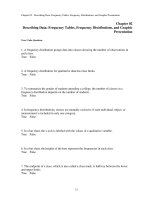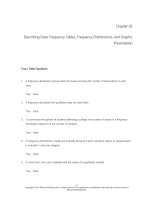Lecture Statistical techniques in business and economics - Chapter 8: Sampling methods and central limit theorem
Bạn đang xem bản rút gọn của tài liệu. Xem và tải ngay bản đầy đủ của tài liệu tại đây (3.86 MB, 47 trang )
8 1
Sa m p l i n g
Methods
&
Central Limit Theorem
Copyright © 2004 by The McGrawHill Companies, Inc. All rights reserved.
8 2
When you have completed this chapter, you will be able to:
1.
Explain under what conditions sampling is the
proper way to learn something about a population.
2.
Describe methods for selecting a sample.
3.
Define and construct a sampling distribution
4.
of the sample mean.
Explain the central limit theorem.
5.
Use the central limit theorem to find probabilities of
selecting possible sample means from
a specified population.
Copyright © 2004 by The McGrawHill Companies, Inc. All rights reserved.
8 3
We use sample information
We use sample information
to make
to make
decisions or inferences
decisions or inferences
about the population.
about the population.
Two KEY
KEY steps:
steps:
Two
1. Choice of a proper method for selecting sample data
&
2. Proper analysis of the sample data (more later)
KEY 1.
KEY 1.
Copyright © 2004 by The McGrawHill Companies, Inc. All rights reserved.
8 4
Copyright © 2004 by The McGrawHill Companies, Inc. All rights reserved.
8 5
KEY 1.
KEY 1.
If the proper
method for selecting
the sample is
NOT MADE … the SAMPLE
will not be truly
representative of the
TOTAL Population!
… and wrong conclusions can be drawn!
Copyright © 2004 by The McGrawHill Companies, Inc. All rights reserved.
Why Sample the Population?
Why Sample the Population?
8 6
Because…
…of the physical impossibility of checking
all items in the population, and,
also, it would be too timeconsuming
$
…the studying of all the items in a population
would NOT be cost effective
…the sample results are usually adequate
…the destructive nature of certain tests
Copyright © 2004 by The McGrawHill Companies, Inc. All rights reserved.
Techniques
8 7
with Replacement
with Replacement
without Replacement
without Replacement
Each data unit in the
Each data unit in the
population is allowed to
population is allowed to
appear in the sample
appear in the sample
more than once
more than once
Each data unit in the
Each data unit in the
population is allowed to
population is allowed to
appear in the sample
appear in the sample
no more than once
no more than once
robability SSampling
ampling
PProbability
NonProbability Sampling
NonProbability Sampling
Each data unit in the
Each data unit in the
population
population
has a known
has a known
likelihood
likelihood
of being
of being
included in the sample
included in the sample
Does not
not involve
involve
Does
random selection;
random selection;
inclusion of an item
inclusion of an item
is
is
based on convenience
convenience
based on
Copyright © 2004 by The McGrawHill Companies, Inc. All rights reserved.
Methods
Simple Random
Systematic Random
Stratified Random
Cluster
8 8
...each item(person) in the population
has an equal chance of being included
…items(people) of the population
are arranged in some order.
A random starting point is selected, and
then every kth member of the population
is selected for the
…a population is
sample
first divided into subgroups, called
strata, and a sample is selected from each
strata
…a population is
first divided into primary
units, and samples are
selected from each unit
Copyright © 2004 by The McGrawHill Companies, Inc. All rights reserved.
Terminology
“Sampling error”
8 9
… is the difference between
… is the difference between
a sample statistic
a sample statistic
and its
and its
corresponding population
corresponding population
parameter
parameter
“Sampling distribution … is a probability distribution
… is a probability distribution
consisting of
of the sample
consisting of
mean”
all possible sample means
all possible sample means
of a given sample size
of a given sample size
selected from a
selected from a
population
population
Example
Example
Copyright © 2004 by The McGrawHill Companies, Inc. All rights reserved.
8 10
The law firm of Hoya and Associates has five partners.
At their weekly partners meeting each reported the
number of hours they billed their clients last week:
Partner
Hours
Example
Example
Dunn
22
Hardy
26
Kiers
30
Malinowski
26
Tillman
22
If two partners are selected randomly…
If two partners are selected randomly…
how many different samples are possible?
how many different samples are possible?
Copyright © 2004 by The McGrawHill Companies, Inc. All rights reserved.
8 11
If two partners are selected randomly…
If two partners are selected randomly…
how many different samples are possible?
how many different samples are possible?
Partner
Dunn
Hardy
Kiers
Malinowski
Tillman
Hours
22
26
30
26
22
Objects
5
…taken 2 at a time
…for a Total of 10 Samples!
Using 55C
C2 2 …
…
Using
Copyright © 2004 by The McGrawHill Companies, Inc. All rights reserved.
8 12
If two partners are selected randomly…
If two partners are selected randomly…
how many different samples are possible?
how many different samples are possible?
Partner
Dunn
Hardy
Kiers
Malinowski
Tillman
Hours
22
26
30
26
22
Copyright © 2004 by The McGrawHill Companies, Inc. All rights reserved.
Objects
C
C
2 =
55 2 =
5
5!
=
2! (5 – 2!)
= 10 Samples
= 10 Samples
8 13
Partners
1&2
1&3
1&4
1&5
2&3
2&4
2&5
3&4
3&5
4&5
Samples of 2
(22+26)/2 =
(22+30)/2 =
(22+26)/2 =
(22+22)/2 =
(26+30)/2 =
(26+26)/2 =
(26+22)/2 =
(30+26)/2 =
(30+22)/2 =
(26+22)/2 =
Copyright © 2004 by The McGrawHill Companies, Inc. All rights reserved.
Mean
24
26
24
22
28
26
24
28
26
24
8 14
Mean
24
26
24
22
28
Example …continued
Example …continued
Organize the sample means
sample means
Organize the
into a Sampling Distribution
into a Sampling Distribution
Sample Mean Frequency
Relative frequency
s
e
s
l
e
p
l
p
m
Probability Sam
Sa
0
10
1
1/10
26
22
1
24
24
4
4/10
26
3
3/10
28
2
2/10
28
26
24
Copyright © 2004 by The McGrawHill Companies, Inc. All rights reserved.
8 15
Example …continued
Example …continued
Compute the mean of the sample means.
Compute the mean of the sample means.
Compare it with the population mean
Compare it with the population mean
Frequency
22
1
24
4
26
3
28
2
X
Sample Mean
Copyright © 2004 by The McGrawHill Companies, Inc. All rights reserved.
22(1)+ 24(4)+ 26(3) + 28(2)
10
= 25.2
= 25.2
8 16
Example …continued
Example …continued
The population mean is also the same as
Note The population mean is also the same as
the sample means…25.2 hours!
the sample means…25.2 hours!
Partner
Dunn
Hardy
Kiers
Malinowski
Tillman
Hours
22
26
30
26
22
Copyright © 2004 by The McGrawHill Companies, Inc. All rights reserved.
22 26 30 26 22
5
= 25.2
= 25.2
8 17
entral LLimit
imit TTheorem
heorem
CCentral
The sampling distribution of the means
of all possible samples of
size n
generated from the population
will be approximately
Sampling Distributions:
Sampling Distributions:
normally distributed!
Mean (µx ))
µµ
Mean (µ
x
Variance
Variance
Standard Deviation
Standard Deviation
(standard error of the mean)
(standard error of the mean)
X
Copyright © 2004 by The McGrawHill Companies, Inc. All rights reserved.
/n
/n
22
/ n
8 18
oint EEstimates
stimates
PPoint
A point estimate is one value ( a single point)
that is used to estimate a population
parameter
sample mean
sample standard deviation
sample variance
sample proportion
Copyright © 2004 by The McGrawHill Companies, Inc. All rights reserved.
More
8 19
oint EEstimates
stimates
PPoint
opulation follows… P
Population does NOT follow…
opulation does NOT follow…
PPopulation follows…
the normal distribution
the normal distribution
the normal
the normal
distribution
distribution
If the sample is of at least 30
If the sample is of at least 30
observations, the sample WILL
observations, the sample WILL
follow the normal distribution
follow the normal distribution
The sampling distribution
The sampling distribution
of the sample means also follows
of the sample means also follows
the normal
the normal
distribution
distribution
Probability of a sample mean Probability of a sample mean
Probability of a sample mean
Probability of a sample mean
falling within a particular region, falling within a particular region,
falling within a particular region,
falling within a particular region,
use:
use:
use:
use:
Z = X
Z = X
n
n
s
Copyright © 2004 by The McGrawHill Companies, Inc. All rights reserved.
8 20
entral LLimit
imit TTheorem
heorem
CCentral
Chart 8 – 6 Results for Several Populations
Chart 8 – 6 Results for Several Populations
Copyright © 2004 by The McGrawHill Companies, Inc. All rights reserved.
8 21
Generating
259
Random Numbers
3
1
1
in Excel
Copyright © 2004 by The McGrawHill Companies, Inc. All rights reserved.
Using
8 22
ls
o
o
T
n
o
k
c
i
l
C
See
See
Click on DATA
Click on DATA
ANALYSIS
ANALYSIS
See…
Copyright © 2004 by The McGrawHill Companies, Inc. All rights reserved.
Using
8 23
See
See
Highlight RANDOM NUMBER GENERATION
…Click OK
See…
Copyright © 2004 by The McGrawHill Companies, Inc. All rights reserved.
Using
8 24
See
See
1
0
100
Cl
K
O
n
o
k
ic
20
INPUT NEEDS
INPUT NEEDS
$A:$A
See…
Copyright © 2004 by The McGrawHill Companies, Inc. All rights reserved.
Using
See
See
8 25
If you want whole numbers, use the
If you want whole numbers, use the
FUNCTION WIZARD (f
(fx)
)
FUNCTION WIZARD
x
to ROUND to the nearest integer.
to ROUND to the nearest integer.
Copyright © 2004 by The McGrawHill Companies, Inc. All rights reserved.









